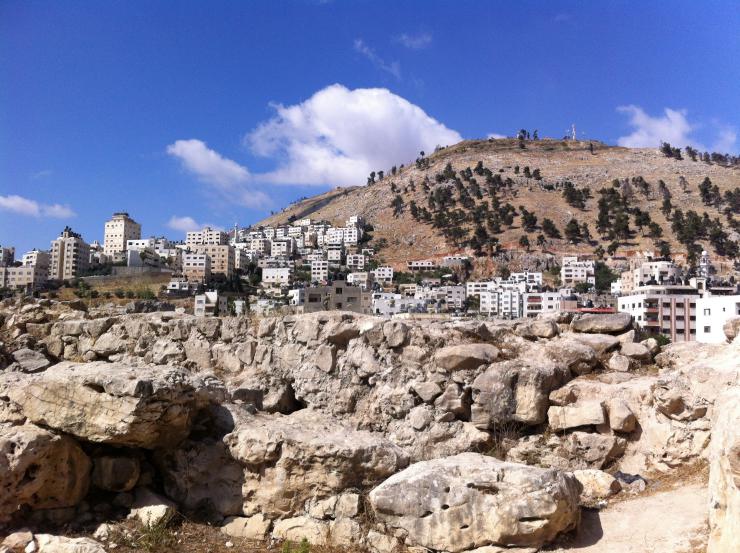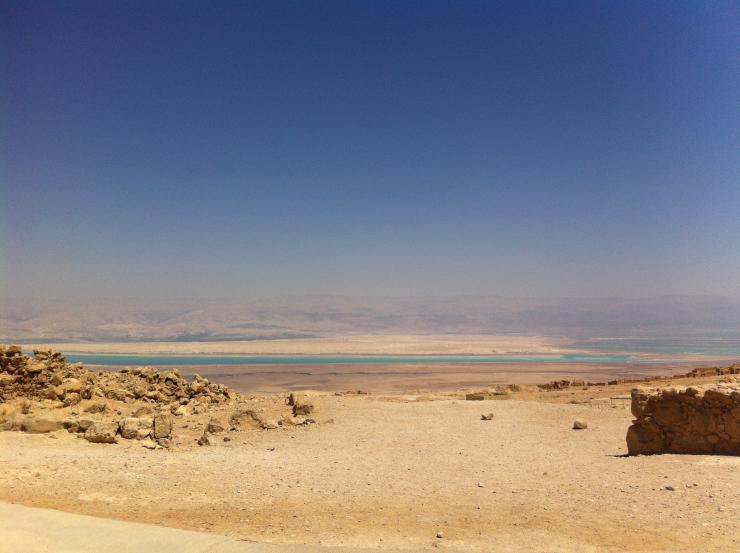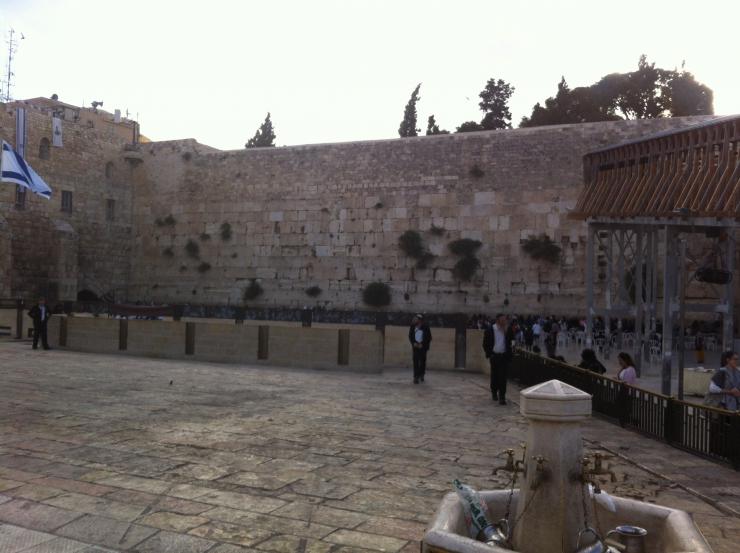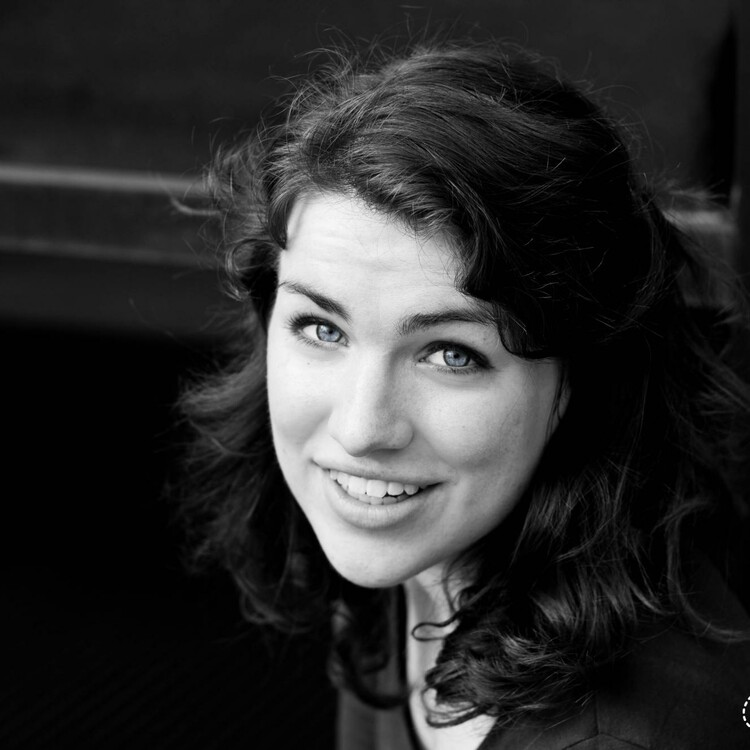Writing a Play Begins with Listening
In the summer of 2017, I traveled to Israel and Palestine to write a play about the origins of my faith. The branch of Christianity I practice—Roman Catholicism—has been deeply molded by Europe’s own historical developments, but has at its core a Semitic, Middle Eastern figure from a culture completely foreign to me. What was the story of this culture at the heart of the faith I practice, and how could I find that story in the land and the people who live there now?
As I sought the answers to those questions, I joined a long line of pilgrims, immigrants, and travelers of all stripes who have arrived on the shores of the land of Canaan seeking what was most sacred to them: a glimpse of the divine, belonging, home. And, like many others before me, I walked into the international entanglement of nations and religions who claim their origins in this region as well.
Playwrights build characters, wind them up, and then watch them go. If, however, the playwright is writing honestly, she senses her characters have a reality that exists above and beyond her own artistic machinations.
Three of the globe’s largest and most powerful religions all have a stake in this land. For followers of Islam, the Al-Aqsa mosque on al-Haram-al-Sharif in the heart of Jerusalem marks the spot where the prophet Muhammad ascended to heaven. For millennia, Jews all over the world have revered that same spot, Temple Mount, as the most sacred site in all of Judaism. To Christians, the city of Jerusalem marks where their founder, Jesus Christ, submitted himself to public torture and execution, and from where his followers, spurred on by the belief that he had in fact risen from the dead, spread the message of his resurrection to the entire Near Eastern world and beyond.
These religious claims to the land are mirrored in the competing national claims to the land, in particular to Jerusalem, which continues to remain an epicenter of political and religious contention. Naturally, this activates an instinct to resolve tensions into one coherent narrative, and prompts sincere—even if unanswerable—questions: Which of these competing claims should be privileged? Which has the greater validity?
Before embarking on my travels, I sat down with a wise and kind Italian professor who shared with me his own experiences traveling in Israel, first as a young boy and, years later, as a professor. His advice: “Spend your energy listening to everyone you encounter. Don’t get caught up in trying to figure out who is right. You will exhaust yourself.”

I had little idea before I left just how difficult—yet ultimately salvific—my professor’s advice would prove. Playwriting, a colleague once suggested to me, is more like journalism than creative writing. He meant, I think, that there is a real creativity to the craft of playwriting: playwrights build characters, wind them up, and then watch them go. If, however, the playwright is writing honestly, she senses her characters have a reality that exists above and beyond her own artistic machinations. In order to write authentic characters, the playwright must recognize her characters as somewhat—to borrow a phrase of Rowan Williams—“resistant to [her own] self.” The characters are unique and authentically other. Thus, a playwright is a on a journalistic drive to get to the bottom of these strange people, to dig up the “real” story within them.
As I experienced in both Israel and Palestine, talking to people from the area, I found myself in a mire of contradicting narratives, none of which I could have totally anticipated. But there was no way around them. In order to understand the story of this culture, of my own faith, I would have to understand the competing histories that presented themselves to me.
One of the top twenty-five most popular TED talks is Chimamanda Ngozi Adichie’s “The danger of a single story.” Adichie walks listeners through several different moments of cultural clashes, where the reduction of a culture, family, or person to a single story—a simple, often-patronizing stereotype that fails to encompass the complexities of that person’s background—influences how two members of different cultures interact. Often these single stories or stereotypes serve to reinforce the “otherness” of a person. The danger, notes Adichie, is not that it is simply “a” single story, but that it becomes “the” story.
During my travels, I confronted many of the single stories I had previously absorbed, through rhetoric prevalent in the United States, about the Arab world. All too frequently, Arab and Islamic nations are caricaturized in American discourse, even in the subtle linguistic choices of news pundits, as fundamentally violent, sexist, and inhospitable to Westerners.
When I went to visit a new friend in Nablus, deep in the heart of the West Bank, the bus route involved a transfer. I boarded a bus at the seam of Jerusalem’s East and West sides, hopping off in Ramallah, with an outline of a map and a confident sense of direction to navigate myself to the next bus, which would bring me to my destination. The chaos of Ramallah’s city center could confuse the compass points in even the most seasoned traveler’s mental map, and I found myself turning in circles.
Men shouted out to me: “Do you need help?” Usually wary of answering calls from men on the street, I responded that I did need help finding the bus station, and they warmly pointed the way, sending me in the right direction with good wishes for a safe journey. This was hardly the response to a young Western woman traveling alone I had been led to expect.
As the bus sped through the fertile undulating hills of Samaria, my eyes took in the rich earth and the mottled carpet of green, brown, and auburn grasses. The stories I had absorbed over the past two weeks of visiting the West Bank had confirmed my single story of the place: one of refugee camps, barbed wire, ugly separation walls, and litter in the streets. But this gorgeous landscape unfolding outside my window challenged my expectations and opened up a new story of this land.

Throughout my travels, when speaking with Palestinians, I learned their single story of Israel: soldiers making midnight arrests, bullets through kitchen windows, unprovoked tear gas attacks. Hearing about injustice, it is difficult not to instantly side with the person wronged. But the Israeli citizens I spoke to also recited histories of violence: acquaintances harmed in bus bombings, family members killed in war, and living under rocket fire and fear. They were suspicious of interlocutors who claimed they would work towards peace, but whose real intention seemed to be divesting them of their home. Because many of their parents and grandparents emigrated to Israel from the horrors of the Shoah, Israelis naturally hold tightly to this land, which met their ancestors with the promise of safety and belonging.
As I drank in all these stories, felt the pain of angry rants, listened to vitriol, and conversed with concerned citizens, I found myself unwittingly getting caught up in searching for “the” story I wanted to tell. Who was telling me the truth? How could I reconcile one person’s truth with another’s? I was trapped by the impossible task of trying to reduce a constellation of narratives into one all-encompassing solution.
Growing frustrated, I recalled again my professor’s advice: “Don’t get caught up in trying to figure out who’s right. You will exhaust yourself.” The artist’s role in the midst of conflict is not to find the solution for the questions that present themselves. At the same time, an artist cannot be blind to propaganda, false narratives intended to harm others, or blatant disregard for truth. Recording, listening, and honoring the stories of others does not mean disregarding reality. But, in truth, no one group has a corner on suffering; no one community can be blamed alone for violence.
Who was telling me the truth? How could I reconcile one person’s truth with another’s? I was trapped by the impossible task of trying to reduce a constellation of narratives into one all-encompassing solution.
In listening to the Israelis and Palestinians, I found that overwhelming numbers of both parties desire peace and actively work for it. Varying weights of responsibility for the nations’ long history of grievances certainly fall on each side. The redistribution of guilt and innocence among them does not erase the pain of wrongs done, but ought to only make their need to be redressed more exigent. I believe the best and most beautiful stories do seek justice and do have a care for the common good. As for the artist, being part of a just peace means honoring the complex, often-contradicting stories of the people she meets.
I returned home last summer with no answers to my questions, and little certainty about the relationship between my Catholic faith, its culture and land of origin, and the current conflict that overwhelms it today. The land did indeed hold the story of my faith, but it was not simply calcified in stone ruins or preserved in the beauty of its topography. It is a living one, which means the story I went to seek was not buried in two thousand years of history, but is currently unfolding in the narratives swirling around me.
As I continue conversations with Jewish women who have made aliyah, Palestinian refugees who have been separated from their homes for decades, as I continue to learn about this place and its peoples’ entangled history and intersecting cultures, I learn to let go of my need to find “the” story. The full narrative slowly reveals itself, hidden in the heart of the tangled, throbbing, joyful mess of lives lived with and against each other.
Only a commitment to live in the complexity allows me to see each strand of this land’s story, which is unique, magnificent, beautiful, and endlessly surprising. I have discovered characters I never could have invented: a rabbinic student who resisted the draft and was tortured in prison, a mother who raised a child with disabilities in the midst of a refugee camp, theatre artists—Palestinian and Israeli—who give hope and power to youth by teaching them to make something beautiful.

Throughout my travels in the thick of this intractable international conflict, I found that the power of just one person’s story is in its simplicity. The temptation of what Adichie calls “the” single story is that it seeks to reduce all the personal, individual stories into a single one—easily grasped, manipulated, or dismissed. As “the” single story reduces the “other” to a quantity we already know, can control, and can predict, their own personal story reveals a new world within each person, one that we can discover, in the words of the poet Christian Wiman, is “most intimately me/ and not mine.”
While not a foolproof solution to resolve all human conflict, listening to truth as it presents itself in its confusing and beautiful manifestations in other people is a powerful tool for peace. Telling personal stories in the face of totalizing stereotypes offers a road—an avenue of heartfelt encounter—that may not end armed conflict or heal centuries-old division, but could, potentially, showcase something familiar and human in the face of the foreign other.
Christianity is a faith that believes very powerfully in the story of a single person—it has passed them down for two thousand years. It believes that they, somehow, show the hidden face of the deity to humanity. As I have sought the story of my own faith—of one man, in one place, many centuries ago—I have come to find that is a story preserved in a place by the people who give that place life.
Telling the stories of others does not necessarily offer political solutions, nor can storytelling obviously reconcile tensions and divisions deeply calcified throughout the centuries. Rather, telling one person’s story allows us to see through the haze of contradictions to the shape of a human being on the other side. These individual narratives of life, death, and resurrection, occurring on the most intimate human level, become the foundation of art that can reveal the divine.


Comments
The article is just the start of the conversation—we want to know what you think about this subject, too! HowlRound is a space for knowledge-sharing, and we welcome spirited, thoughtful, and on-topic dialogue. Find our full comments policy here
I love this! Adichie's TED Talk is my favorite of all time, and I share it in most classes that I teach. I think it definitely resonates with playwriting. I love your description of this craft as a form of journalism in which the writer frames things and then lets the characters essentially break their own single stories. I'm sure this insight and experience will benefit your play greatly. I'll be on the look-out for the production!
Yes. In NYC I've heard the stories on many sides - Zionists and settlers who returned to NYC. Two State advocates, Ramallah camp volunteers, Arabs, Iranians, holocaust survivors, Christian evangelicals believing that violent chaos in Jerusalem is the path to future salvation, calmer Christians focused on Jesus' station of the cross and the stable... each with anguish and anger against the other. Some self-righteously sure that killing for their cause is justified. We need Mandela and Archbishop Tutu's Truth and Reconciliation commission - a rich source of human action for us playwrights. www.anntares.com